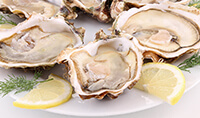Oysters — the Elite of the Gastronomic Word

People living on the shores of warm seas have extracted and used oysters in foods since the Roman Empire. The ancient Romans experienced the beneficial properties of oysters and, in particular, the increase in loving energy. The emperors of Ancient Rome were paid for this delicacy with gold equivalent by weight.
The famous lover of the 18th century, Casanova, daily for breakfast consumed 50 oysters and, given this example, it was studied by scientists who made the hypothesis that this delicacy is a powerful aphrodisiac. Subsequently, several scientists from the U.S.A and Italy examined bivalve molluscs and found that they contain a large number of rare amino acids contributing to the rapid production of sex hormones.
The meat of the oyster contains protein, fat, minerals (iron, zinc, copper, calcium, iodine, phosphorus), niacin and vitamins B1, B2, B12 and PP. Just 6 oysters offer the daily requirement for iron and copper! In the early XIX century, in France and England, oysters were considered the food of the poor who do not have enough money for beef or pork. However, the uncontrolled catch of oysters led to their rapid decline and, within a century, they had soared in value, becoming a delicacy.
Oysters have useful properties which, combined with their low calorie content, can be called an ideal food for people who care about their health and appearance. Below we have provided some interesting facts about oysters that will really surprise you.
1. Oysters have two sexes and can change throughout life, influenced by various factors. It’s funny that, usually, oysters begin their lives as “men” and, when getting ready for procreation, become “women”.
2. Rule for the letter “R” means that oysters should be eaten only in months with the letter “r” in them. This is just a myth. This confusion has a historical background. Once, with the aim of conservation of their oysters during their breeding season (May to August), they had banned the use of oysters as food. Eventually, prohibitions were removed, but the rule has now become a myth. According to experts, the most delicious oysters are in March.
3. Oysters are perfectly combined with absinthe. Usually, oysters are served with champagne or wine, but this delicacy goes well with absinthe. Salty, mineral-rich oysters create a stunning symbiosis of flavour, with mint and fennel in the composition of absinthe.
4. Oysters improve the environment. Oysters are natural filterers, clearing an average of 50 litres of water every day. When you look at the clear and deep ocean, think about the oysters that contributed to such beauty.
5. Oysters are low in calories. 100 g of oysters have 95 calories. This is the same as 100 grams of tuna or 100 grams of veal. 100 g of oysters (about 6 pieces) has 17 grams of protein. It is, on average, around the daily needs of man.
6. The size of the oysters is represented by numbers and zeros. The more zeros, the larger the oyster. Four scratch are from 120 g, three scratch are between 100g and 120 g, two scratch are between 90g and 100 g, one scratch are 80 g, 1 are 70 g, 2 are 60 g and 3 are 50 g.
7. Giant clam can reach lengths of 38 cm, but the European types usually have a shell length of 8-12 cm
8. Real European flat oysters (Ostrea edulis) manage to live mostly only in Croatia.
The classic method of eating oysters is eating them alive with cheese, served on pieces of crushed ice or sprinkled with lemon juice. They can spice up with some black pepper or can be dipped into a special vinegar sauce. Oysters can be baked, boiled, fried or cooked in batter.
Treat yourself and decorate your Christmas table with a dozen oysters. After all, for the coming year of the red rooster, it is better to meet with seafood and meat dishes in order to attract good fortune and success.









